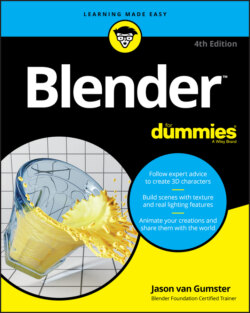Читать книгу Blender For Dummies - Jason van Gumster - Страница 74
Numerical input
ОглавлениеNot only can you use hotkeys to activate the various transform modes, but you can also use the keyboard to explicitly input exactly how much you would like your object to be transformed. Simply type the number of units you want to change after you activate the transform mode.
As an example, suppose that you want to rotate your object 32 degrees around the global X-axis. To do so, press R ⇒ X ⇒ 32 and confirm by pressing Enter. Translate your object -26.4 units along its local Y-axis by pressing G ⇒ Y ⇒ Y ⇒ -26.4 ⇒ Enter. These steps can be a very quick and effective means of flipping or mirroring an object because mirroring is just scaling by -1 along a particular axis. For example, to flip an object along the global Z-axis, press S ⇒ Z ⇒ -1 ⇒ Enter. For consistency, these numerical input operations are also available when using the 3D manipulator.
As mentioned briefly in Chapter 2 when covering the Preferences editor, Blender has the ability to use mathematical equations as part of the numerical input system. This system is called the Blender’s advanced numerical input system. To take advantage of this feature, press the Equal (=) key before entering your numerical input. As an example, say you have a model of a car that’s 4.6 meters long; you want to move it along the Y-axis by 6 car lengths. Sure, you could do the math in your head (or with a calculator, if necessary), but it’s even easier to let Blender handle the math for you by pressing G ⇒ Y ⇒ =4.6*6 ⇒ Enter. This advanced numerical input system even allows for simple math functions and constants, such as sine, cosine, and pi (π). So, if you find that you need to rotate an object about its X-axis by the cosine of 2π (that’s 1°, by the way), you could use the following key sequence: R ⇒ X ⇒ =cos(2*pi) ⇒ Enter. If you’re coming from an industrial design or architecture background, this is an immensely useful feature.
